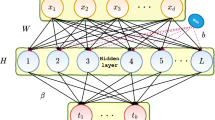Abstract
Neural networks have been successfully applied to many applications due to their approximation capability. However, complicated network structures and algorithms will lead to computational and time-consuming burdens. In order to satisfy demanding real-time requirements, many fast learning algorithms were explored in the past. Recently, a fast algorithm, Extreme Learning Machine (ELM) (Huang et al. 70:489–501, 2006) was proposed. Unlike conventional algorithms whose neurons need to be tuned, the input-to-hidden neurons of ELM are randomly generated. Though a large number of experimental results have shown that input-to-hidden neurons need not be tuned, there lacks a rigorous proof whether ELM possesses the universal approximation capability. In this paper, based on the universal approximation property of an orthonormal method, we firstly illustrate the equivalent relationship between ELM and the orthonormal method, and further prove that neural networks with ELM are also universal approximations. We also successfully apply ELM to the identification of QoS violation in the multimedia transmission.
Similar content being viewed by others
References
Huang G-B, Zhu Q-Y, Siew C-K (2006) Extreme learning machine: theory and applications. Neurocomputing 70: 489–501
Ito Y (1991) Approximation of functions on a compact set by finite sums of a sigmoid function without scaling. Neural Netw 4: 817–826
Leshno M, Lin VY, Pinkus A, Schocken S (1993) Multilayer feedforward networks with a nonpolynomial activation function can approximate any function. Neural Netw 6: 861–867
Hornik K (1991) Approximation capabilities of multilayer feedforward networks. Neural Netw 4: 251–257
Kaminski W, Strumillo P (1997) Kernel orthonormalization in radial basis function neural networks. IEEE Trans Neural Netw 8(5): 1177–1183
Huang G-B, Zhu Q-Y, Siew C-K (2006) Real-time learning capability of neural networks. IEEE Trans Neural Netw 17(4): 863–878
Stein EM, Shakarchi R (2005) Real analysis: measure theory, integration, and Hilbert spaces. Princeton University Press, NJ
Huang G-B, Chen L, Siew C-K (2006) Universal approximation using incremental constructive feedforward networks with random hidden nodes. IEEE Trans Neural Netw 17(4): 879–892
Blake C, Merz C (1998) UCI repository of machine learning databases. http://www.ics.uci.edu/~mlearn/MLRepository.html, Department of Information and Computer Sciences, University of California, Irvine, USA
Poellabauer C, Abbasi H, Schwan K (2002) Cooperative run-time management of adaptive applications and distributed resources. In: Proceedings of ACM multimedia
Li B, Nahrstedt K (2000) Qualprobes: middleware qos profiling services for configuring adaptive applications. In: Proceedings of IFIP international conference on distributed systems platforms and open distributed processing
Author information
Authors and Affiliations
Corresponding author
Rights and permissions
About this article
Cite this article
Chen, L., Zhou, L. & Pung, H.K. Universal Approximation and QoS Violation Application of Extreme Learning Machine. Neural Process Lett 28, 81–95 (2008). https://doi.org/10.1007/s11063-008-9083-z
Received:
Accepted:
Published:
Issue Date:
DOI: https://doi.org/10.1007/s11063-008-9083-z




